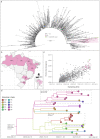A Potential SARS-CoV-2 Variant of Interest (VOI) Harboring Mutation E484K in the Spike Protein Was Identified within Lineage B.1.1.33 Circulating in Brazil
- PMID: 33919314
- PMCID: PMC8143327
- DOI: 10.3390/v13050724
A Potential SARS-CoV-2 Variant of Interest (VOI) Harboring Mutation E484K in the Spike Protein Was Identified within Lineage B.1.1.33 Circulating in Brazil
Abstract
The severe acute respiratory syndrome coronavirus 2 (SARS-CoV-2) epidemic in Brazil was dominated by two lineages designated as B.1.1.28 and B.1.1.33. The two SARS-CoV-2 variants harboring mutations at the receptor-binding domain of the Spike (S) protein, designated as lineages P.1 and P.2, evolved from lineage B.1.1.28 and are rapidly spreading in Brazil. Lineage P.1 is considered a Variant of Concern (VOC) because of the presence of multiple mutations in the S protein (including K417T, E484K, N501Y), while lineage P.2 only harbors mutation S:E484K and is considered a Variant of Interest (VOI). On the other hand, epidemiologically relevant B.1.1.33 deriving lineages have not been described so far. Here we report the identification of a new SARS-CoV-2 VOI within lineage B.1.1.33 that also harbors mutation S:E484K and was detected in Brazil between November 2020 and February 2021. This VOI displayed four non-synonymous lineage-defining mutations (NSP3:A1711V, NSP6:F36L, S:E484K, and NS7b:E33A) and was designated as lineage N.9. The VOI N.9 probably emerged in August 2020 and has spread across different Brazilian states from the Southeast, South, North, and Northeast regions.
Keywords: Brazil; E484K; SARS-CoV-2; genomic epidemiology; variant of Interest.
Conflict of interest statement
The authors declare no conflict of interest.
Figures

References
-
- Resende P.C., Delatorre E., Graf T., Mir D., Motta F.C., Appolinario L.R., Dias da Paixao A.C., da Fonseca Mendonca A.C., Ogrzewalska O., Caetano B., et al. Evolutionary dynamics and dissemination pattern of the SARS-CoV-2 lineage B.1.1.33 during the early pandemic phase in Brazil. Front. Microbiol. 2021;11:1–14. doi: 10.3389/fmicb.2020.615280. - DOI - PMC - PubMed
-
- Naveca F., Nascimento V., Souza V., Corado A., Nascimiento F., Silva G., Costa A., Duarte D., Pessoa K., Mejia M., et al. COVID-19 epidemic in the Brazilian state of Amazonas was driven by long-term persistence of endemic SARS-CoV-2 lineages and the recent emergence of the new Variant of Concern, P.1. [(accessed on 1 March 2021)];Res. Sq. 2021 preprint. Available online: https://www.researchsquare.com/article/rs-275494/v1.
Publication types
MeSH terms
Substances
Grants and funding
LinkOut - more resources
Full Text Sources
Other Literature Sources
Medical
Miscellaneous

